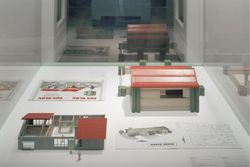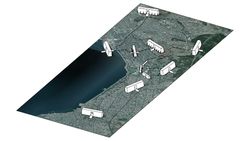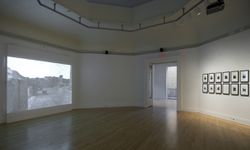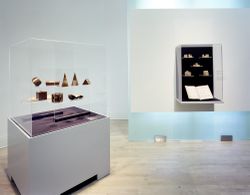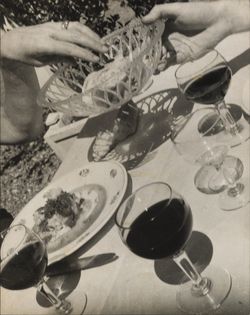Série(s)
AP144.S2
Description:
Series documents Cedric Price's projects from his early work in the late 1950s to work dating from the time he founded his own practice in 1960 until 2000. Material includes numerous competition entries, planning and building projects, transportation-related projects, exhibitions, conceptual projects, furniture and interior designs, and monuments, follies, and decorations. Some projects also reflect his teaching, research, lecture and publication activities. Price also worked on several competition juries (see projects Musique, Elephant). Many of Cedric Price's projects in the series are unexecuted. Significant unrealized projects from the 1960s and 1970s include Fun Palace (1961-1974), Potteries Thinkbelt (1963-1967), Oxford Corner House (1965-1966), and Generator (1976-1980). Significant built projects from the same period include the New Aviary (1960-1966), his first major realized project (with Lord Snowdon and Frank Newby), and Inter-Action Centre (1971-1979). Other realized projects include an office building (BTDB Computer, 1968-1973) and restaurant (Blackpool Project, 1971-1975). Planning projects from the 1960s and 1970s include Potteries Thinkbelt, Detroit Think Grid (1969-1971) and Rice University's design charette, Atom (1967). In the 1980s and 1990s, Cedric Price worked on several building proposals including greenhouses (Serre, Serre (2)), museums, galleries, and pavilions (Trafalgar, Pertpavs, Snake), a railway station (Strate (2)), a cultural centre (Tiff), houses (Perthut, Castel), a bus station (Walsall), an aviary (CP Aviary) and office buildings (Domain, Berlin). Planning projects from the same time include parks and cultural complexes, (Parc, South Bank), urban areas, (Strate, Stratton, IFPRI, Haven, Mills), university campuses (Frankfurt, Unibad, Bedford), and rural areas (Stark, Arkage). Transportation-related projects include railways (Strate, Control, Rink), roadways (Stratton) and pedestrian links (Magnet, Halmag, South Bank). Only a few of his projects from that period were executed and those include the renovation projects Congress and SAS 29; a mobile market stall design for Westminster City Council (Westal) for which prototypes were built; a coffee cup design (Crowbar); and building conversion projects Gatard and Juke. Exhibition projects in the series include some devoted to Cedric Price's works (AA Exhibition, Aedes, AFX, Afella), some designed by him (Strike, Food for the Future, Topolski/Waterloo, Ashmole, Mean, AFX), as well as projects designed for exhibition (Citlin, Castel). The series also contains self-financed research and client-less projects, which form a significant part of Cedric Price's practice. Undertaken in anticipation of future clients or new planning needs, they include research into air structures and lightweight enclosures as well as integrated construction and transportation solutions (Trucksafe Air Portable Dock Ahoy), and housing research. South Bank, Magnet, and Duck Land represent a few of the client-less projects. The material in this series documents Cedric Price's work in the United Kingdom, in particular England (the Greater London area, and other areas) and Scotland, Germany, France, Austria, Australia, Japan, the United Arab Emirates, and the United States and other locations such as Canada, Nigeria, and Norway. Major clients include J. Lyons & Co. (Oxford Corner House), David Keddie (Two Tree Island, Southend Roof), Howard Gilman (Generator), British Railways (Strate and Strate (2), and others), the McAlpine family , particularly Alistair McAlpine, and their company Sir Robert McAlpine & Sons Ltd. (McAppy, Perthut, Trafalgar, Pertpavs, Ashmole, Perth, Obeliq, McVance); Établissement Public du Parc de la Villette (Parc, Serre, Serre (2), Musique) and the Canadian Centre for Architecture (IFPRI, Mean). He collaborated with several architects and engineers during the course of his career, his closest association being with engineer Frank Newby and quantity surveyor Douglas Smith. Some of his other collaborators include engineer Max Fordham (Strate (2), Tiff, Berlin), engineering firms Scott Wilson Kirkpatrick and Partners (Stratton, Rink, Control), and Sir Frederick Snow & Partners (South Bank), cybernetician Gordon Pask (Kawasaki/Japnet), architectural firm YRM/Yorke Rosenberg Mardall (Unibad), and architect Richard Rogers (Marman). He also collaborated with members of Archigram on the Trondheim Competition, (1972-1974), and with John and Julia Frazer who provided the computer modelling for Generator. David Price, Cedric Price's brother was the model maker for several projects. The series contains conceptual drawings, design development drawings, reference drawings and maps, presentation drawings (particularly for competitions), and working drawings. A significant amount of textual records are included, especially for projects involving a large amount of research or publicity (Air Structures, Lightweight Enclosures, South Bank, CP Aviary, Stratton), for executed projects, and for the larger unrealized projects like Fun Palace and Generator. Also includes photographic materials of project sites and models. Some models included in the series are made from durable materials (wood, metal, plastic), while others are in-office constructions made out of paper, cardboard and Fome-Cor (TM). Of particular note are the 11 models for Magnet, and a full-size prototype of a market stall for Westal. Series also contains publication layouts, including material for the "Cedric Price Supplement", 'Architectural Design' vols. 40- 42 (1970-1972). Changes in office practice are noted around 1971, evident in the Blackpool Project and later, including the adoption of the metric system, and the creation of working and detail drawings on A4 size paper and filed with textual records (e.g. approximately 300 such drawings are included in the textual records for Blackpool Project). At the same time fewer preamble drawings that relate to site sensing, progress and life-cycle graphs and tables are created for the projects (a common feature from the 1960s), although project progress tables are still used. Of particular interest is material in the Early Work and Miscellaneous Records file (AP144.S2.D1) that relates to office work methods and programmes.
1903-2003, predominant 1960-2000
Projects
Actions:
AP144.S2
Description:
Series documents Cedric Price's projects from his early work in the late 1950s to work dating from the time he founded his own practice in 1960 until 2000. Material includes numerous competition entries, planning and building projects, transportation-related projects, exhibitions, conceptual projects, furniture and interior designs, and monuments, follies, and decorations. Some projects also reflect his teaching, research, lecture and publication activities. Price also worked on several competition juries (see projects Musique, Elephant). Many of Cedric Price's projects in the series are unexecuted. Significant unrealized projects from the 1960s and 1970s include Fun Palace (1961-1974), Potteries Thinkbelt (1963-1967), Oxford Corner House (1965-1966), and Generator (1976-1980). Significant built projects from the same period include the New Aviary (1960-1966), his first major realized project (with Lord Snowdon and Frank Newby), and Inter-Action Centre (1971-1979). Other realized projects include an office building (BTDB Computer, 1968-1973) and restaurant (Blackpool Project, 1971-1975). Planning projects from the 1960s and 1970s include Potteries Thinkbelt, Detroit Think Grid (1969-1971) and Rice University's design charette, Atom (1967). In the 1980s and 1990s, Cedric Price worked on several building proposals including greenhouses (Serre, Serre (2)), museums, galleries, and pavilions (Trafalgar, Pertpavs, Snake), a railway station (Strate (2)), a cultural centre (Tiff), houses (Perthut, Castel), a bus station (Walsall), an aviary (CP Aviary) and office buildings (Domain, Berlin). Planning projects from the same time include parks and cultural complexes, (Parc, South Bank), urban areas, (Strate, Stratton, IFPRI, Haven, Mills), university campuses (Frankfurt, Unibad, Bedford), and rural areas (Stark, Arkage). Transportation-related projects include railways (Strate, Control, Rink), roadways (Stratton) and pedestrian links (Magnet, Halmag, South Bank). Only a few of his projects from that period were executed and those include the renovation projects Congress and SAS 29; a mobile market stall design for Westminster City Council (Westal) for which prototypes were built; a coffee cup design (Crowbar); and building conversion projects Gatard and Juke. Exhibition projects in the series include some devoted to Cedric Price's works (AA Exhibition, Aedes, AFX, Afella), some designed by him (Strike, Food for the Future, Topolski/Waterloo, Ashmole, Mean, AFX), as well as projects designed for exhibition (Citlin, Castel). The series also contains self-financed research and client-less projects, which form a significant part of Cedric Price's practice. Undertaken in anticipation of future clients or new planning needs, they include research into air structures and lightweight enclosures as well as integrated construction and transportation solutions (Trucksafe Air Portable Dock Ahoy), and housing research. South Bank, Magnet, and Duck Land represent a few of the client-less projects. The material in this series documents Cedric Price's work in the United Kingdom, in particular England (the Greater London area, and other areas) and Scotland, Germany, France, Austria, Australia, Japan, the United Arab Emirates, and the United States and other locations such as Canada, Nigeria, and Norway. Major clients include J. Lyons & Co. (Oxford Corner House), David Keddie (Two Tree Island, Southend Roof), Howard Gilman (Generator), British Railways (Strate and Strate (2), and others), the McAlpine family , particularly Alistair McAlpine, and their company Sir Robert McAlpine & Sons Ltd. (McAppy, Perthut, Trafalgar, Pertpavs, Ashmole, Perth, Obeliq, McVance); Établissement Public du Parc de la Villette (Parc, Serre, Serre (2), Musique) and the Canadian Centre for Architecture (IFPRI, Mean). He collaborated with several architects and engineers during the course of his career, his closest association being with engineer Frank Newby and quantity surveyor Douglas Smith. Some of his other collaborators include engineer Max Fordham (Strate (2), Tiff, Berlin), engineering firms Scott Wilson Kirkpatrick and Partners (Stratton, Rink, Control), and Sir Frederick Snow & Partners (South Bank), cybernetician Gordon Pask (Kawasaki/Japnet), architectural firm YRM/Yorke Rosenberg Mardall (Unibad), and architect Richard Rogers (Marman). He also collaborated with members of Archigram on the Trondheim Competition, (1972-1974), and with John and Julia Frazer who provided the computer modelling for Generator. David Price, Cedric Price's brother was the model maker for several projects. The series contains conceptual drawings, design development drawings, reference drawings and maps, presentation drawings (particularly for competitions), and working drawings. A significant amount of textual records are included, especially for projects involving a large amount of research or publicity (Air Structures, Lightweight Enclosures, South Bank, CP Aviary, Stratton), for executed projects, and for the larger unrealized projects like Fun Palace and Generator. Also includes photographic materials of project sites and models. Some models included in the series are made from durable materials (wood, metal, plastic), while others are in-office constructions made out of paper, cardboard and Fome-Cor (TM). Of particular note are the 11 models for Magnet, and a full-size prototype of a market stall for Westal. Series also contains publication layouts, including material for the "Cedric Price Supplement", 'Architectural Design' vols. 40- 42 (1970-1972). Changes in office practice are noted around 1971, evident in the Blackpool Project and later, including the adoption of the metric system, and the creation of working and detail drawings on A4 size paper and filed with textual records (e.g. approximately 300 such drawings are included in the textual records for Blackpool Project). At the same time fewer preamble drawings that relate to site sensing, progress and life-cycle graphs and tables are created for the projects (a common feature from the 1960s), although project progress tables are still used. Of particular interest is material in the Early Work and Miscellaneous Records file (AP144.S2.D1) that relates to office work methods and programmes.
Series
1903-2003, predominant 1960-2000
Nul n’ignore l’incroyable synergie propre aux expositions universelles (millions de visiteurs, étalage monumental de marchandises et d’idées, magnifiques décors des pavillons et des salles d’exposition), mais peu de gens s’arrêtent aux lieux mêmes, qui pourtant donnent aux expositions une unité spatiale. Images de villes idéales : les expositions universelles traite du(...)
Vitrines
17 mars 1993 au 1 août 1993
Images de villes idéales : les expositions universelles
Actions:
Description:
Nul n’ignore l’incroyable synergie propre aux expositions universelles (millions de visiteurs, étalage monumental de marchandises et d’idées, magnifiques décors des pavillons et des salles d’exposition), mais peu de gens s’arrêtent aux lieux mêmes, qui pourtant donnent aux expositions une unité spatiale. Images de villes idéales : les expositions universelles traite du(...)
Vitrines
documents textuels
ARCH256925
Description:
15 files - District 4-5 Plan from Borough of North York (1971); Orion Financial Group correspondence; blank forms; technical literature; research on concert halls/theatres; research on earth-sheltered architecture; letter from AEA expressing interest in submitting projects to Architectural Biennale Competition in Sofia, Bulgaria (1987); correspondence concerning computers; project status reports; 4 miscellaneous folders of correspondence concerning: talk with Dr. Hollenberg, office policies and memos, CCA exhibition catalogue (1987), requests for information, magazine clippings, minutes, Canadian Who's Who, King Abdulaziz University, Mundipharma, University of Arizona, Etisalat floor patterns, Town of Markham invoice, requests, press clippings, letters to AE, inter-office memos.
1971, 1987-1988
District 4-5 Plan from Borough of North York
Actions:
ARCH256925
Description:
15 files - District 4-5 Plan from Borough of North York (1971); Orion Financial Group correspondence; blank forms; technical literature; research on concert halls/theatres; research on earth-sheltered architecture; letter from AEA expressing interest in submitting projects to Architectural Biennale Competition in Sofia, Bulgaria (1987); correspondence concerning computers; project status reports; 4 miscellaneous folders of correspondence concerning: talk with Dr. Hollenberg, office policies and memos, CCA exhibition catalogue (1987), requests for information, magazine clippings, minutes, Canadian Who's Who, King Abdulaziz University, Mundipharma, University of Arizona, Etisalat floor patterns, Town of Markham invoice, requests, press clippings, letters to AE, inter-office memos.
documents textuels
1971, 1987-1988
À partir de jeux et de jouets d’architecture choisis dans la collection du CCA, y compris 33 jouets d’architecture nord-américains et européens datant du début du XIXe siècle jusqu’à 1995, Maisons de rêve, maisons jouets examine les notions de domicile, d’enfance, de jeu, d’apprentissage et de rôle déterminé selon le sexe. Cette exposition montre comment les jouets(...)
Maisons de rêve, maisons jouets
Actions:
Description:
À partir de jeux et de jouets d’architecture choisis dans la collection du CCA, y compris 33 jouets d’architecture nord-américains et européens datant du début du XIXe siècle jusqu’à 1995, Maisons de rêve, maisons jouets examine les notions de domicile, d’enfance, de jeu, d’apprentissage et de rôle déterminé selon le sexe. Cette exposition montre comment les jouets(...)
Andreas Angelidakis définit sa pratique comme un seul et même projet continu qui porte sur l’architecture d’exposition. Dans cette conférence, il décrira son parcours en se basant sur cinq exemples : la troisième Biennale de Thessalonique, The System of Objects à la DESTE Foundation à Athènes, Every End Is a Beginning au musée national d’art contemporain à Athènes, 1:1(...)
15 octobre 2015 , 18h
L'architecture présentée : Andreas Angelidakis
Actions:
Description:
Andreas Angelidakis définit sa pratique comme un seul et même projet continu qui porte sur l’architecture d’exposition. Dans cette conférence, il décrira son parcours en se basant sur cinq exemples : la troisième Biennale de Thessalonique, The System of Objects à la DESTE Foundation à Athènes, Every End Is a Beginning au musée national d’art contemporain à Athènes, 1:1(...)
L’artiste conceptuel britannique Victor Burgin exerce une grande influence à la fois comme artiste et comme théoricien de l’image statique et mobile. Commandé par le CCA, Voyage en Italie comprend deux séries de photographies en noir et blanc, de même qu’une vidéo évocatrice, qui illustrent la beauté intemporelle et la résonance d’une photographie du XIXe siècle de Carlo(...)
Salle octogonale
7 décembre 2006 au 25 mars 2007
Victor Burgin : voyage en Italie
Actions:
Description:
L’artiste conceptuel britannique Victor Burgin exerce une grande influence à la fois comme artiste et comme théoricien de l’image statique et mobile. Commandé par le CCA, Voyage en Italie comprend deux séries de photographies en noir et blanc, de même qu’une vidéo évocatrice, qui illustrent la beauté intemporelle et la résonance d’une photographie du XIXe siècle de Carlo(...)
Salle octogonale
Apprendre de toutes pièces
Le jouet d’architecture évoque d’emblée le monde des « vrais » bâtiments dont il reproduit en miniature les colonnes, les arcs et les fenêtres. L’exposition Apprendre de toutes pièces, par ailleurs, s’inspire des formes géométriques élémentaires présentes dans la nature : cubes, sphères, cônes, cylindres, tiges et prismes. Ces jouets servent aussi bien à construire et à(...)
Salle octagonale
16 décembre 1992 au 25 avril 1993
Apprendre de toutes pièces
Actions:
Description:
Le jouet d’architecture évoque d’emblée le monde des « vrais » bâtiments dont il reproduit en miniature les colonnes, les arcs et les fenêtres. L’exposition Apprendre de toutes pièces, par ailleurs, s’inspire des formes géométriques élémentaires présentes dans la nature : cubes, sphères, cônes, cylindres, tiges et prismes. Ces jouets servent aussi bien à construire et à(...)
Salle octagonale
Les progrès de la technique, aussi bien que les conditions sociales, politiques et économiques, ont de tout temps influencé les architectes. L’exposition Les jouets et la tradition moderniste examine la manière dont les fabricants de jouets ont reçu les multiples idées novatrices des architectes modernes. Plusieurs des jouets exposés ont été conçus par des figures(...)
16 décembre 1993 au 1 mai 1994
Les jouets et la tradition moderniste
Actions:
Description:
Les progrès de la technique, aussi bien que les conditions sociales, politiques et économiques, ont de tout temps influencé les architectes. L’exposition Les jouets et la tradition moderniste examine la manière dont les fabricants de jouets ont reçu les multiples idées novatrices des architectes modernes. Plusieurs des jouets exposés ont été conçus par des figures(...)
Visite guidée
À noter
L’exposition À noter témoigne des moments clés de la relation continue qui unit écriture et architecture. Lexposition est la cinquième d’une série d’expositions réalisées en collaboration avec des universités. Commissaire : Sylvia Lavin, University of California, Los Angeles.
Salle octogonale
4 février 2010 au 30 mai 2010
À noter
Actions:
Description:
L’exposition À noter témoigne des moments clés de la relation continue qui unit écriture et architecture. Lexposition est la cinquième d’une série d’expositions réalisées en collaboration avec des universités. Commissaire : Sylvia Lavin, University of California, Los Angeles.
Salle octogonale

